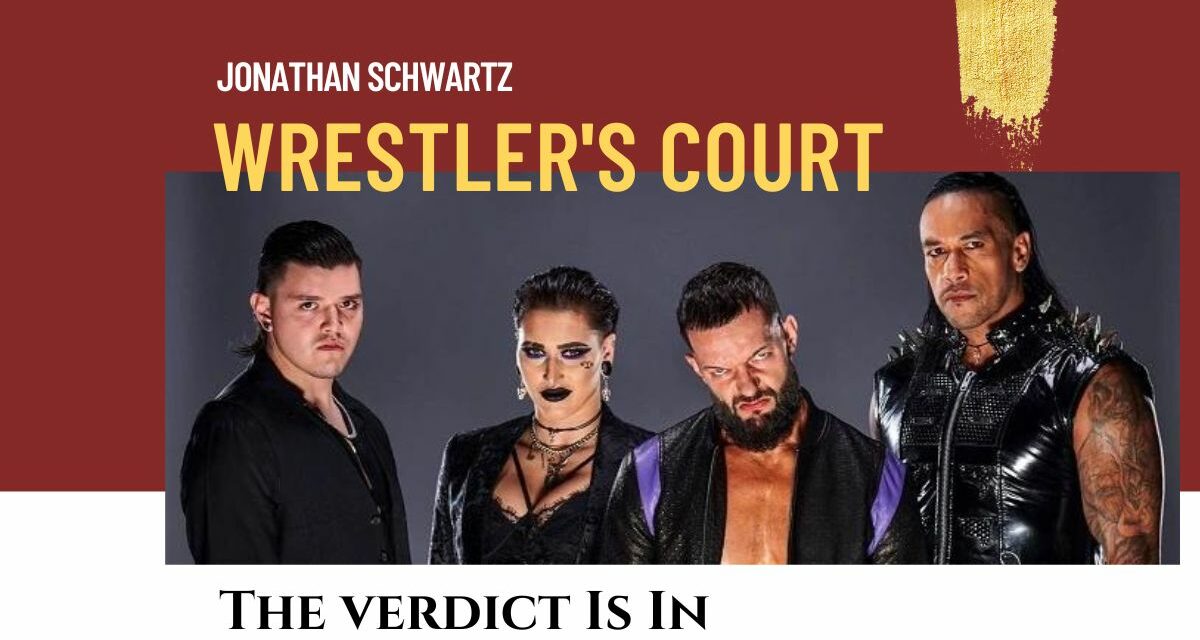It may come as a surprise that I have a few hobbies apart from watching and writing about pro wrestling.
One of these hobbies has a lot to do with watches.
I own a couple of modest pieces which I enjoy but devote most of my energy to reading and learning about the expensive stuff — watches that were considered groundbreaking (or completely unappreciated) when brand new, but which have become part of a much broader design language since then.
If you’re also an enthusiast, you probably know what a Rolex Submariner, Cartier Tank, Patek Phillipe Nautilus or Omega Speedmaster look like. If not, don’t worry, you’ve seen variations of them all at every price point in stores from Wal-Mart to the boutiques that sell the real things. Heck, if you’d rather stay home you can buy a watch off Amazon. It will help make my point since whether you buy a fashion piece, a ‘serious’ manufacture or one of the inexpensive alphabet soup brands that populate online retail, you’ll quickly notice how these newer, less expensive watches ‘borrow’ elements made famous by the originals. It could be the shape of the watch; the types of markers or numerals on its face; the style of hands used to tell time; or embellishments like the ring surrounding the face (that’s called the bezel).
An awful lot of watches call back to a few key models. A cynic would call them knockoffs of successful, unattainably expensive or discontinued products. An enthusiast on a modest budget would more likely call them “homages” — watches that start with an established formula and change it just enough to be perceived as different. This practice can lead to heated arguments between watch nerds (admittedly, we fight over single millimeters in case size and the existence of date windows), since the closer your homage is to the original, the more appealing it may be to people like myself, who wouldn’t dream of spending car money on an admittedly outmoded way to tell time… but the closer you edge to ‘rip off’ territory, especially if the manufacturer fails to acknowledge its debt to historic designs.
Which, as with all things, brings me to pro wrestling.
Watching the recent Royal Rumble, I was struck by how three quarters of the Judgment Day stable pay homage to earlier wrestlers. Since his heel turn Dominik Mysterio has altered his look, presentation and move set to more closely resemble his alleged late father, Eddie Guerrero. He’s sprouted a wicked mullet, taken Eddie’s frog splash for a finisher and started dressing in period-correct clothing. He’s also part of an on-screen romance with a black-haired leather wearing muscular ‘Mami’ (as he calls her) Rhea Ripley, who won the Women’s Rumble match while appropriating parts of the late Chyna’s act. Damien Priest has also gotten involved, shifting his character from happy go lucky gothic party dude to heel with anger issues, to a smoother customer who affects many of the late Scott Hall’s mannerisms and dress. Watch Priest as he enters the ring: he glides along the Razor’s edge as Hall did to avoid contact with fans. His ring gear includes elements from Hall’s old nWo fit. It’s incongruous, and potentially problematic. Eddie’s widow Vickie Guerrero was alleged to have recently stated that Dominik failed to ask the family’s permission to appropriate Eddie’s likeness. She is offended by what she sees as a cut-rate, unauthorized impersonation — a fake, and is hurt by attempts to label Dominik as ‘the next Eddie Guerrero’ when, while he may be developing the comedy part, his work as a serious performer has considerable room for improvement (she has since denied speaking to the outlet that reported these remarks; score one more for the wrestling rumor mill). Priest’s appropriation of Razor Ramon is somewhere between surreal and problematic. Priest, who is Puerto Rican, is paying tribute to a character that was supposed to be Cuban-American, played by a performer who apparently did not have a Hispanic background. I’ll get to the second Razor Ramon, a Canadian no less, later.
Seen together, the influences on Judgment Day are clear even if they don’t all come together in time or space. I don’t remember a ton of interaction between Hall and Guerrero in WCW or WWE, and while Chyna might have accompanied HHH early in his Kliq membership she doesn’t seem to factor in much when people mention that faction. Finn Balor comes across as an outlier. He has experience leading a stable, but his Bullet Club run was based on building a group based on high-performing, ‘foreign’ heels before a Japanese audience, and in that context Balor and friends could be an effective Foreign Menace. Here, less so. He’s just dastardly after usurping control of the group from Edge. I do think Judgment Day is one member away from greatness, but I’ll get to that in time as well.
This is probably the sort of minute distinction that hardcore fans will argue and the rest of the world will ignore, but the same way as watch fans will draw a line between homages and outright fakes — the kind you buy on Wish or the trench coat pockets of unscrupulous street vendors, complete with the original’s logo and other stolen intellectual property (although some high end fakes may be near duplicates in terms of quality) — Judgment Day offers a look into a more complicated view of how wrestling characters can pass between the people who play them.
To wit, I suggest that there is a distinction between homages, tropes and outright fakes.
An homage involves a current wrestler borrowing aspects of an older wrestler’s act but putting their own spin on it. A good homage acknowledges the source material but does more than an impersonation. Vickie Guerrero may not have made the remarks attributed to her, but the concerns sounded credible enough to be picked up by less careful wrestling media. Whoever made up Vickie’s quote picked up on something we all recognize. Nobody is going to mistake Dominik for Eddie Guerrero. So far Dom-Dom is playing up the humorous aspects of Eddie’s old “lie, cheat, steal” persona as well as calling back to an angle he participated in as a child where his paternity was questioned.
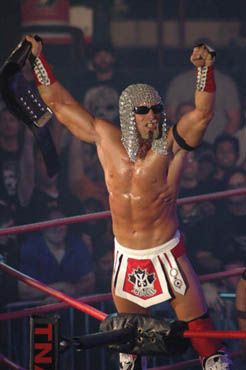
Little Poppa Pump. SlamWrestling.net archives
Homages in wrestling focus on the appropriation of a single wrestler’s character: When Chris Jericho transitioned from the Ayatollah of Rock and Rollah to a more serious, suit-wearing heel with an expanded vocabulary and slower pace he openly acknowledged that he was channeling Nick Bockwinkel. Lower down the card, Rico Constantino’s flamboyant stylist gimmick was an homage to Exotic Adrian Street. Superstar Billy Graham’s blond, colorful, tough-talking bodybuilder spawned generations of homages, including Jesse “The Body” Ventura, Scott “Big Poppa Pump” Steiner and Hulk Hogan. Each of those men started with the model established by SBG. Each took it in a wildly different direction informed by changes in wrestling and what society would bear. Steiner himself spawned an homage during his time in TNA when Petey Williams dyed his hair and beard to match Steiner’s and found himself his own chainmail hood as “Little Poppa Pump” or “Maple Leaf Muscle.” Williams played his homage for laughs but grew a minor cult following.
“Nature Boy” Buddy Rogers inspired a litany of blond pretty boy wrestlers who mixed technical acumen with a propensity for cheating. Ric Flair is the obvious homage, although his approach to the character was always more antic. Buddy Landel also used the nickname, and I’d argue his take on the character was a bit more in line with Rogers’, even if Flair’s version played better on TV. I think that you could draw a line from Flair to Seth Rollins’ current incarnation. He’s borrowed the backstage wardrobe and colorful ring gear, although his use of clothing to taunt opponents (like reverting to his Shield gear to fight Roman Reigns, or borrowing Dusty Rhodes’ Polka Dots against Cody Rhodes) feels more like a call-back to Rick Rude’s airbrushed tights.
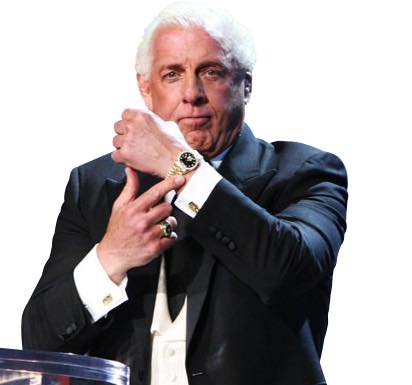
Ric Flair … the Rolex-wearing …
The Sheik has spawned legions of imitators — and may be credited in part with the birth of a whole hardcore style of wrestling. Without him there’s no Abdullah the Butcher or Sabu or Iron Sheik. A newer ‘Sheik’ briefly held the NWA World Heavyweight championship before Billy Corgan took it over, and was most recently in MLW as manager Josef Samael.
I look at ‘evil’ or ‘supernatural’ gimmicks from Undertaker to Kane to Bray Wyatt, Abyss, Aleister/Malakai Black and Karrion Kross as flowing from Kevin Sullivan’s revolutionary 1980s heel work in Florida. Sullivan played off current events and a national concern over the alleged rise of occult beliefs to create a character and stable that stopped just short of outright Satanism. It was over the top in the best way. Sullivan still uses it; he recently featured in a short film designed to get over Karrion Kross’ ties to the dark side. I imagine it was produced without WWE’s knowledge since Sullivan very clearly swears on camera.
A trope may emerge where an homage grows beyond a performer and into a stock character. Tropes may be tougher to track since they predate wrestling’s explosion in popularity in the television age, but it’s safe to say that if you think of a stereotype there’s a lineup of wrestlers behind it. I’ve written before about the advent of Soviet/Russian super-heels since the Cold War. The same could be said of the fake Nazis who wrestled into the early 1980s, the ‘devious’ Japanese wrestlers who evolved (kinda) from wartime xenophobia to economic xenophobia into the 2000s, the ‘wildmen’ from the Pacific Islands and ‘deepest darkest Africa’, and stoic ‘Native Americans’. More locally whichever groups were associated with organized crime would join the fray. Surprisingly WWE still milks this last one. Tony D’Angelo and Channing ‘Stacks’ Lorenzo play roles in NXT that would have fit in with Lou Albano and Tony Altamore’s old Sicilians tag team.
Some tropes have receded as social mores change. The Usos and Roman Reigns aren’t portrayed like their fathers and grandfathers were. It’s hard to imagine Saba Simba or Kamala being rehashed, and wrestling seems to be moving away from what we would now call ‘appropriation’ where one could be assigned a new ethnicity and told to play it up for the cameras. As beloved as Chief Jay Strongbow may have been, watching a middle-aged Italian American from Martha Stewart’s home of Nutley, New Jersey, wear a full war bonnet and do a ‘war dance’ has not aged well.
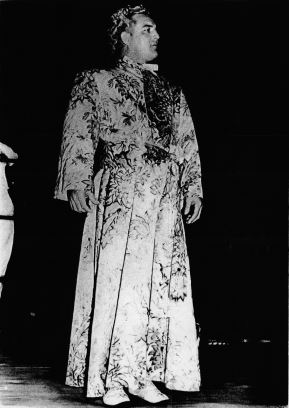
The original Gorgeous George.
One of the first, most successful tropes is the effeminate ‘gay’ stereotype first advanced by Gorgeous George. George was a journeyman wrestler/boxer well into his career when he discovered that television cameras loved his bleached-blond hair, sequined robes and valet spraying him with perfume (or disinfectant) before his matches. George is also credited with the first entrance music: Elgar’s “Pomp and Circumstance” (later used, along with the robes and valet but not the signifying by Randy “Macho Man” savage). Interestingly, George’s mannerisms changed once the bell rang; he could be a vicious heel and was always presented as a tough guy in-ring. The same could be said of Exotic Adrian Street or Adrian Adonis, who was given a similar gimmick as punishment for gaining weight. You can draw a through-line to Goldust (who only turned face after rejecting Jerry Lawler’s asking him whether he was “queer”) or tag team act Billy and Chuck who pushed the envelope further by playing an ambiguously gay duo. WWE backed off that angle too, with them revealing it was a mind game when they were about to get married on TV. I don’t think this trope will ever truly go away, although increasingly wrestlers who are actually members of the LGBTQ2+A community like Darren Young or Sonya Deville acknowledge it and just move on to their matches rather than making gender identity the total of their characters.
This gimmick often overlaps with another trope, the intellectual heel, where the likes of ‘The Genius’ Lanny Poffo or Damien Sandow would court boos by prancing around the ring, wearing wigs or wearing ‘unmanly’ colors like pink or purple. This gimmick is also a throwback. Wrestling has had plenty of ‘Professors’ like Roy Shire, Boris Malenko or Dale Lewis, and ‘Doctors’ like Jerry Graham (who’s degree was in hypnosis). Alleged murderer Sam Sheppard wrestled professionally to capitalize on his infamy; he was a real doctor, too. More recently, lawyers have come to the fore as cowardly heels with advanced degrees. I still think David Otunga deserved a Honkytonk Man style run with the Intercontinental Championship.
A fake (a deadly world in wrestling to begin with) involves a performer appropriating another’s identity outright, without permission to use things like the original wrestler’s ring name, entrance music or costume design. Some promoters in the United Kingdom infamously ran shows promising the likes of the Road Warriors, The Undertaker, Stone Cold Steve Austin or The Rock. They delivered (but did not advertise) ‘tributes’ — local talent dressed and painted to look a bit like the originals, but without the skill or physique or talent to back it up. I question how much suspension of disbelief would be involved in thinking Steve Austin would work an indy show in Blackpool before a capacity 200 person crowd, but that’s a different matter.
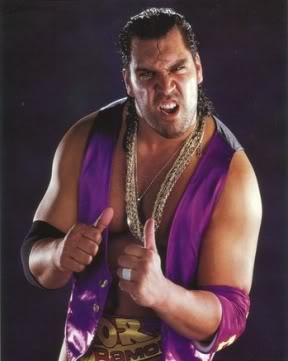
The late Rick Bognar mimicked Razor Ramon.
I debated whether the WWE’s second versions of Diesel (Glenn Jacobs, now better known as Kane) and Razor Ramon (played by Canadian Rick Bognar, of blessed memory) would count as ‘fakes’ in this case. I don’t think they do. Bognar and Jacobs were hired by WWE to play characters that were owned by WWE. The intellectual property I mentioned above all remained with the company, and apart from the audience’s hostile reaction to seeing different performers playing characters they knew and loved, there was no reason WWE could not have reassigned those roles. Undertaker and Kane both worked storylines involving imposter versions of themselves, played by Brian Lee and Luke Gallows, respectively. I don’t think they fall neatly into the typology I propose since they were meant as antagonists to the actual characters during their runs as fan favorites. Neither lasted long in their roles. They were meant to be ‘bizarro’ opponents who might fool audiences until the real Brother of Destruction showed up to run them off.
There’s history here too: multi-time WWF tag team champions Demolition originally consisted of Bill Eadie as Ax and former Moondog Randy Colley as Smash. Colley was replaced by Russian sympathizer Barry Darsow, who had not worked for WWF previously, after fans rejected the team and chanted “Moondog” at Colley during their earliest matches. Demolition themselves could be seen as an homage to the Road Warriors, as could the Powers of Pain. Ironically, WWE fans might say that Demolition had the better run although I think Hawk and Animal are the best tag team of all time.
Face paint and masks helped cover plenty of personnel changes: Konnan abandoned his Max Moon persona and was replaced by Paul Diamond. Matt Borne left Doink the Evil Clown and was replaced by Steve Keirn, Phil Apollo, Dusty Wolfe and others (to say nothing of the many wrestlers who put on the greasepaint since). More recently the original Sin Cara left WWE following a storyline that saw him fight an evil double (i.e. Hunico). Said evil double would then become actual Sin Cara, which may have been the basis for Jordan Peele’s impostor horror flick Us.
Viewed a bit more broadly, you could consider the preponderance of ‘families’ well into wrestling’s boom periods. Some families started out legitimate like the Harts or Vachons or Von Erichs or Duseks… over time consanguinity was ditched in favor of bringing new blood into the act. In some cases, the family existed only in the promoter’s mind. Billy was recruited into the Graham family by Dr. Jerry, who had earlier brought in Eddie and Crazy Luke, none of whom were actual brothers. The Andersons were similarly brothers and cousins and nephews by choice. Ditto the Fabulous Fargos, who may have been fabulous but were never Fargos, and the Valiant Brothers. In the Attitude Era Edge and Christian were initially portrayed as brothers, which was later changed to reflect their real lifelong friendship.
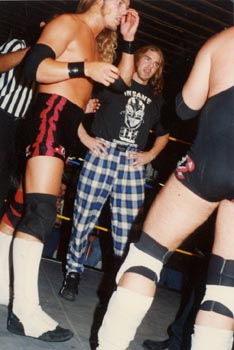
Edge (as Sexton Hardcastle) and Christian Cage. Photo by Terry Dart
Which brings me back to the present Judgment Day. Homages are everywhere in wrestling. They connect us to a history that many promoters prefer not to acknowledge directly. They refresh bigger-than-life characters for modern audiences. They work best when we don’t sweat the details. If my Tiffany-blue sports watch says Timex instead of Rolex I can still enjoy it — maybe more so since I will be less afraid of getting mugged wearing it in public. We live in a world of endless reboots and media properties where characters are readily recast. We can have multiple movies set in alternate versions of Gotham City, each with their own Batman and Joker, to say nothing of a Batwoman series that went through two Batwomen in its three years in production. TV’s Flash has anchored a show through one version of Crisis on Infinite Earths. The movie Flash experienced a different Crisis and may be in rehab as we speak.
The best homages give new life to solid performers; an extra piece to their identity that enriches their persona and helps the audience connect to them. It sparks recognition and can be that ‘something missing’ that gets a wrestler like Mysterio, Ripley or Priest over. All three have been doing their best work in a while. It makes me wonder what performer could be added who might make thematic sense-who is vaguely dark enough that they could benefit from association with a group — maybe in a further homage to a tag team like the Acolytes. Time will tell.
Tick tock, indeed.
TOP PHOTO: The Judgment Day stable of Dominik Mysterio, Finn Balor and Damien Priest. WWE photo
RELATED LINK
